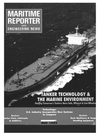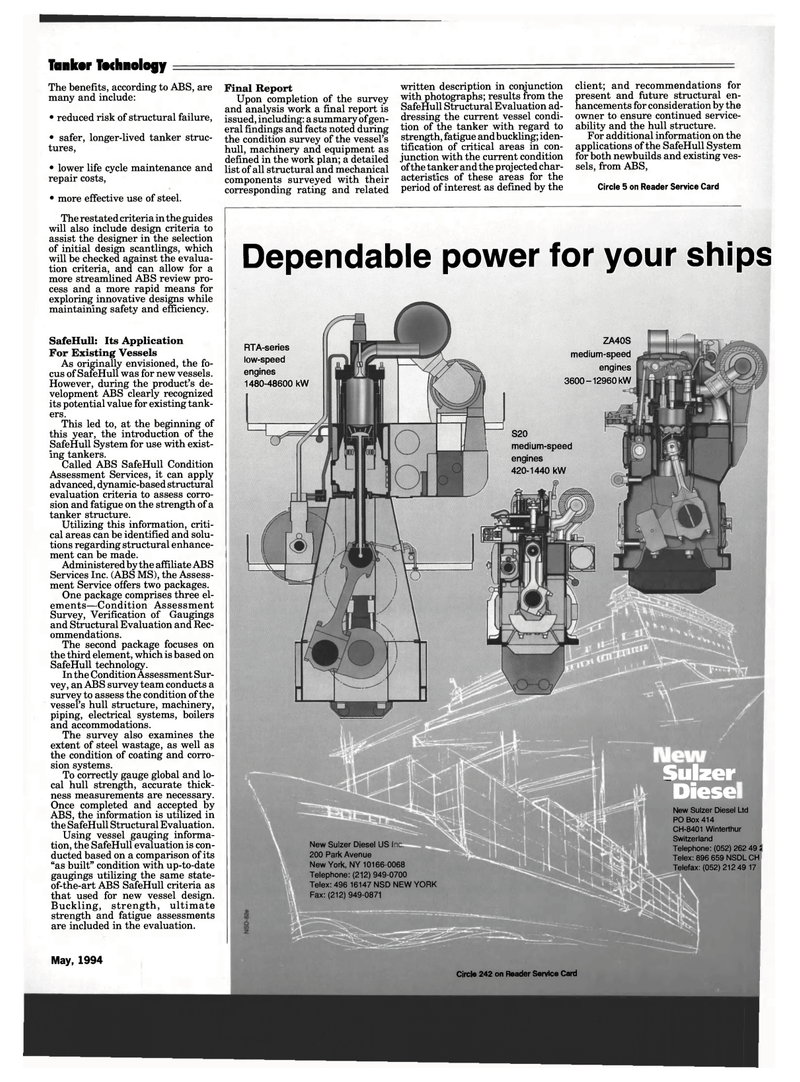
Page 41: of Maritime Reporter Magazine (May 1994)
Read this page in Pdf, Flash or Html5 edition of May 1994 Maritime Reporter Magazine
Tanker Technology
The benefits, according to ABS, are many and include: • reduced risk of structural failure, • safer, longer-lived tanker struc- tures, • lower life cycle maintenance and repair costs, • more effective use of steel.
Final Report
Upon completion of the survey and analysis work a final report is issued, including: a summary of gen- eral findings and facts noted during the condition survey of the vessel's hull, machinery and equipment as defined in the work plan; a detailed list of all structural and mechanical components surveyed with their corresponding rating and related written description in conjunction with photographs; results from the
SafeHull Structural Evaluation ad- dressing the current vessel condi- tion of the tanker with regard to strength, fatigue and buckling; iden- tification of critical areas in con- junction with the current condition of the tanker and the projected char- acteristics of these areas for the period of interest as defined by the client; and recommendations for present and future structural en- hancements for consideration by the owner to ensure continued service- ability and the hull structure.
For additional information on the applications of the SafeHull System for both newbuilds and existing ves- sels, from ABS,
Circle 5 on Reader Service Card
New Sulzer Diesel Ltd
PO Box 414
CH-8401 Winterthur
Switzerland
Telephone: (052) 262 49 £
Telex: 896 659 NSDL CH
Telefax: (052) 212 49 17
Sulzer Diese
The restated criteria in the guides will also include design criteria to assist the designer in the selection of initial design scantlings, which will be checked against the evalua- tion criteria, and can allow for a more streamlined ABS review pro- cess and a more rapid means for exploring innovative designs while maintaining safety and efficiency.
SafeHull: Its Application
For Existing Vessels
As originally envisioned, the fo- cus of SafeHull was for new vessels.
However, during the product's de- velopment ABS clearly recognized its potential value for existing tank- ers.
This led to, at the beginning of this year, the introduction of the
SafeHull System for use with exist- ing tankers.
Called ABS SafeHull Condition
Assessment Services, it can apply advanced, dynamic-based structural evaluation criteria to assess corro- sion and fatigue on the strength of a tanker structure.
Utilizing this information, criti- cal areas can be identified and solu- tions regarding structural enhance- ment can be made.
Administered by the affiliate ABS
Services Inc. (ABS MS), the Assess- ment Service offers two packages.
One package comprises three el- ements—Condition Assessment
Survey, Verification of Gaugings and Structural Evaluation and Rec- ommendations.
The second package focuses on the third element, which is based on
SafeHull technology.
In the Condition Assessment Sur- vey, an ABS survey team conducts a survey to assess the condition of the vessel's hull structure, machinery, piping, electrical systems, boilers and accommodations.
The survey also examines the extent of steel wastage, as well as the condition of coating and corro- sion systems.
To correctly gauge global and lo- cal hull strength, accurate thick- ness measurements are necessary.
Once completed and accepted by
ABS, the information is utilized in the SafeHull Structural Evaluation.
Using vessel gauging informa- tion, the SafeHull evaluation is con- ducted based on a comparison of its "as built" condition with up-to-date gaugings utilizing the same state- of-the-art ABS SafeHull criteria as that used for new vessel design.
Buckling, strength, ultimate strength and fatigue assessments are included in the evaluation.
Dependable power for your ships
May, 1994
Circle 242 on Reader Service Card
New Sulzer Diesel US I 200 Park Avenue
New York, NY 10166-0068
Telephone: (212) 949-0700
Telex: 496 16147 NSD NEW YORK
Fax: (212) 949-0871
RTA-series low-speed engines 1480-48600 kW
ZA40S medium-speed engines 3600-12960 kW
S20 medium-speed engines 420-1440 kW

 40
40

 42
42
